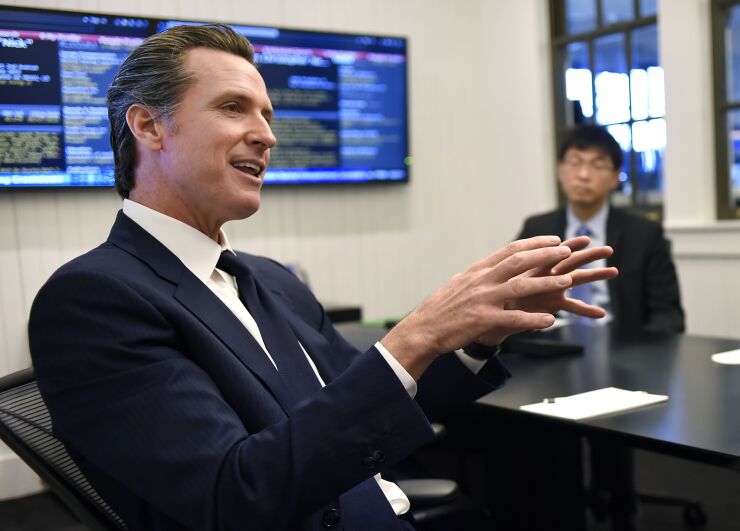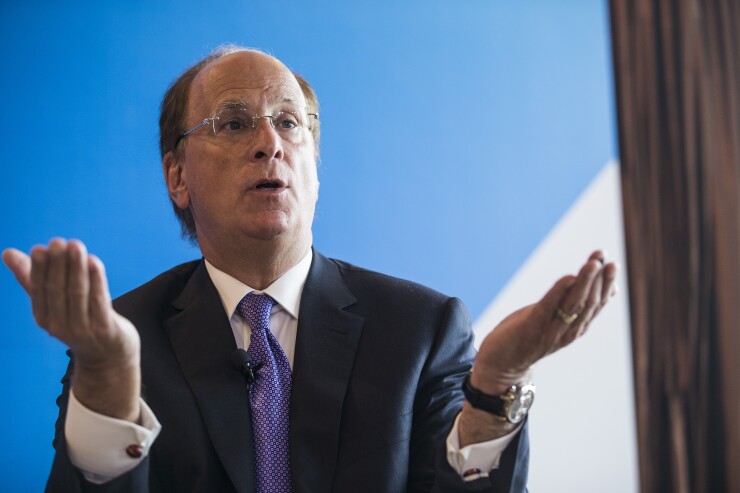California Gov. Gavin Newsom's five-year $12.5 billion climate budget proposal came only a few days before BlackRock's CEO wrote in his annual letter that climate change is reshaping the financial system.
If the state legislature can approve the $4.7 billion climate bond proposed in the governor's budget, the bonds would land in a market with a growing demand for such paper.

Newsom’s $222.2 billion 2020-21 budget is not the first to have a section dedicated to climate change, but the budget takes a broader approach, according to a spokesman.
“There have been iterations of climate change in the budget since the [Arnold] Schwarzenegger administration,” said H.D. Palmer, a spokesman for the California Department of Finance.
In the past, he said, the focus had been on emissions and programs using cap-and-trade funding.
Newsom’s proposed $222.2 billion budget unveiled Jan. 10 takes a multi-pronged approach on funding with its $12.5 billion five-year
This year’s budget proposal includes $1.7 billion in climate-related expenditures. Funding sources are $965 million from cap-and-trade, $250 million from a proposed climate catalyst fund, $169 million in general fund one-time investments, $35 million general fund ongoing expenditures and $308 million from existing bond and special funds.
The five year plan includes support for a $4.7 billion climate bond and creation of a $1 billion Climate Catalyst Fund, a revolving loan fund that would require approval of appropriations in future year budgets.
“Climate change is clearly a long-term issue and the administration feels it requires a long-term commitment,” Palmer said. “The legislature will have to agree to it each year over several years and voters will have to concur this fall in approving the bond measure.”
The proposal aims to tackle climate issues like fire prevention and providing clean drinking water in the near term and also to lay the groundwork for longer-term issues like seawall intrusion, Palmer said.
It combines financing from the general fund for short-term needs like hardening infrastructure for fire prevention with the bond proposal to pay for projects to solve longer-range problems such as tackling rising sea levels, Palmer said.
The administration is also sensitive to the implications of using 30-year bonds, and that there needs to be a high bar that justifies long-term debt, officials said. The governor created the plan in recognition of what officials called a "new normal" in which extreme weather events are expected to become more common.
The governor’s bond proposal, while similar in size to the $4.2 billion bond measure proposed through Senate Bill 45 introduced by Sen. Benjamin Allen, D-Santa Monica, places a greater emphasis on water with $2.9 billion supporting water projects and $750 million for wildfire prevention projects. In Allen’s proposal, wildfires receive the most attention with $1.6 billion going toward reducing the state’s wildfire risk and providing safe drinking water and protecting the state’s water supply from climate risks, the next largest category.
Both bond proposals would also fund projects to protect fish, wildlife and agricultural land and shore up threatened coastal areas.
The climate catalyst fund would create a $1 billion revolving loan fund administered by the California Infrastructure Economic Development Bank in consultation with the Strategic Growth Council and the Labor and Workforce Development Agency.
The fund would receive $250 million from this year’s budget with three additional equal amounts contributed from budgets in years to come that would have to be approved each year during the budget process. Projects would be chosen based on their ability to meet California’s environmental goals and the need to access low-cost borrowing and their ability to provide high-paying jobs.
California voters have a track record of supporting bond measures, but they will also be faced with a $15 billion school construction bond in March.
On June 30, California had more than $35 billion of general obligation debt authorized by voters that had yet to be issued, according to the state treasurer’s 2019 debt affordability
California has the third highest debt as a percentage of gross domestic product at 3.09% in Moody’s Investor Services ranking of the 10 most populous states. Only New York with 3.97% and Illinois with 4.25% have a higher debt burden to GDP, according to Moody’s.
The state
The ratings agencies have lauded the state for paying down debt, building reserves and strengthening its fiscal picture. In its upgrade report, Fitch analysts said, while the state's long-term liabilities are above the median for U.S. states, they remain a moderate burden on the resource base.
Newsom's climate bond proposal came a few days before global asset manager BlackRock announced plans to make climate change central to its investment considerations.

BlackRock, which manages $7 trillion for investors globally, believes that climate change is reshaping the world’s financial system, Larry Fink, the firm’s chairman and chief executive officer, wrote in his
“The evidence on climate is compelling investors to reassess core assumptions about modern finance,” Fink wrote. “In the near future — and sooner than most anticipate — there will be a significant reallocation of capital.”
BlackRock says it will require additional reporting from the companies it invests in, including disclosure of climate-related risks under the Sustainability Accounting Standards Board and report under the Task Force on Climate-related Financial Disclosures guidelines.
As investors price the risk of climate change into their portfolios, Fink said in a CNBC interview, he believes “it is
Tom Kozlik, director and head of municipal strategy and credit for Hilltop Securities Inc., said not only does he agree with Fink, but he thinks his comments and more importantly his shift in strategy are significant for money management in general.
“When one of the largest, if not the largest, money managers writes and talks about allocating capital, it is likely to shift,” Kozlik said. “Investors, issuers and those in the middle, need to acknowledge the new reality.”
Up to now, Kozlik hasn’t seen quantitative evidence of the risk of climate change being priced into municipal bonds, “but a key reason is likely because of the significant amount of demand that exists for municipals and lack of supply,” he said.
“When the supply and demand imbalance falls and time passes, we are likely to see evidence,” Kozlik said. “I absolutely have seen an increasing number of investors who have considered climate-related risks in their analysis and thought process.”





